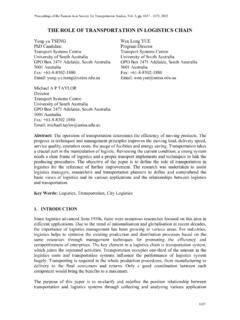Transcription of Industry Analysis The Consulting Industry - BusinessSimplyPut
1 Industry Analysis The Consulting Industry Written by Lori Williams March 28, 2005 2 TABLE OF CONTENTS Introduction/ Overview of Consulting Top Tier Consulting Firms Competitive forces and economic characteristics ..5 Chart detailing economic Chart detailing the five competitive Regional and Local Specialty Boutiques Competitive forces and economic characteristics ..9 Chart detailing economic Chart detailing the five competitive Industry strategic Future Industry Profiles of Selected 3 An Industry Analysis of the Consulting Industry In just over two decades the Consulting Industry has evolved into a multibillion dollar conglomerate. In an article titled Confessions of a Consultant Andrew Wilman recalls the early beginnings of the Industry .
2 Consulting was very different in 1977. It was mainly experience-based. Few consultants had an MBA. The concept of inexperienced research analysts/assistants hired straight out of Oxbridge for their raw analytic horsepower did not exist. Strategy Consulting was hardly known: BCG had just emerged in the US, McKinsey was still pooh-poohing it, Bain did not exist in the UK. Contrast that with 2002. The Industry has mushroomed. Consulting is now a huge part of the business landscape (p. 32-37). By 1998 over 200,000 management Consulting firms were operating in the United States (Harvard Management Update, Rodenhauser). The Industry continues to expand with projected revenues reaching $ billion by the end of 2005 (US Industry Quarterly Review). Consulting Firms- An Overview As defined by government statistics, companies and individuals who function in an advisory capacity are included in the Consulting Industry .
3 SIC and NACIS codes separate firms based on the type of Consulting offered; management, technical or other business related Consulting services. This broad based view fails to recognize the average size of the firm, the internal structure or the auxiliary services the firm offers outside its main classification. For this reason, government coding does not portray an accurate view of the Consulting Industry . The Consulting Industry is comprised of numerous firms varying in size, scope and specialty. Sizes range from large multinational corporations employing thousands of people to smaller regional and local boutiques. The business model and organizational structure of the firms differ as much as the clients they serve. Consultants may operate as employees, contract laborers or independent practitioners.
4 Although some independent practitioners maintain a client base, most work with the smaller firms as contract labor. Independent practitioners find it difficult to do the work and maintain an adequate sales pipeline and consultants by trade are not salespeople. For this reason, most independent practitioners prefer to work for smaller firms than contact clients directly. The larger Consulting organizations are often referred to as top-tier firms. They maintain offices throughout the world and assist corporations with complex business decisions, such as merger and acquisitions, divestures, overseas expansions or complicated growth strategies. Although large in size they are limited in number. The business sector does not support a large number of firms, as there are only so many Fortune 500, 1000 and Global 2000 businesses.
5 Regional and local firms concentrate on a specific discipline and therefore are referred to as specialty boutiques. They target middle market companies, which are defined by revenues between 10 to 100 million. The smaller Consulting firms play an integral role in the economic development of the business community. Middle market companies seldom employ an executive team representing all the major disciplines required for company growth. Often the strength of the company originates from the owners core competencies. The company may have strong capabilities in operation but lack marketing expertise. The smaller Consulting firms fill this crucial gap. They usually work directly with the owner of the company, implementing strategies that promote growth, improve efficiencies, satisfy regulations or incorporate technology.
6 As expressed earlier, the smaller firms frequently utilize independent practitioners as contract labor. In fact, the outward appearance of the firm as portrayed though marketing collateral and company websites, is seldom a true representation of the internal structure. Unknown to most, many of the well-known regional and 4local Consulting firms are comprised solely of independent consultants. The relationships utilize an Industry -wide standard that divides earned income based on revenue generated. The house receives approximately 10% of the revenue which is applied to the overall marketing cost. The consultant who can be credited with making the client introduction will receive 40% to 60%. The remaining portion is divided among the participants of the project.
7 The formation of such strategic alliances has become commonplace; thereby giving the smaller firms the ability to compete with the larger broad based Consulting firms. Using vertical models to analyze the Industry Analyzing this multifaceted landscape in its entirety is difficult. As already illustrated, the size, scope and business models of the individual firms vary. The competitive and economic forces will differ depending of the firm s specific characteristics; its targeted market, specialty and internal structure. Moreover, the companies they target; corporations or smaller business, will respond differently to economic pressures. For this reason, a model categorizing companies based on size offers an effective model to analyze forces, since the size of the firm often dictates the size of the companies they target.
8 For example, Fortune 500 companies typically choose larger Consulting firms. Although Boeing may use smaller firms on a per project basis, the largest portion of Consulting dollars is received by Mckinsey, a large Consulting firm. This is also true for the smaller firms which focus predominately on the middle market companies. The fees they change, as dictated by overhead cost and market forces, are affordable to the companies in this size range. Additionally, the middle market companies can be advantaged by the level of expertise offered by the smaller firms. By grouping the firms by size, distinct similarities can be seen between competitive and economic forces and their resulting affect on the Consulting firm. Specifically, the competitive forces affecting the larger corporations can be discussed in relation to its impact on the larger multinational Consulting firms.
9 The same correlation can be examined through the smaller Consulting firms and the companies they service. This method of categorizing offers the following two verticals:1 Size-Related Model: Top Tier Consulting Firms Regional and local specialty boutiques Subcategory: Individual practitioners However, it is important to note that a size-related model is not a perfect model, since it fails to recognize the specialty of the firm, which also impacts the competitive and economic forces. This holds true for both the large and small Consulting firms. For example; Keane, a top tier Consulting firm concentrates on technology implementation and usage, which is often the hardest hit in recessionary times. Whereas Proxicom is focused on e-business solutions and marketing dollars are often increased during economic downturns as companies compete for declining market share.
10 Smaller firms Consulting on management issues tend to have a larger marketing reach than those who focus predominately on technology solutions. During the dot-com crisis management Consulting firm experienced less of a downturn than their technology counterparts. Therefore categorizing by specialty may provide valuable insight into the structural changes that occur within a firm as a direct result of outside competitive forces. However, one difficulty in this approach is the fact that a specialty- related model is difficult to categorize since many firms have adapted a multi-disciplined approach in order to remain competitive. For example; information technology firms that specialize in IT selection may assist in the implementation and act as a distributor selling the product.




